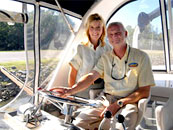Make sure your marine generator is ready for summer.
By Pierce Hoover
Marine generators don’t have it easy. They labor away in tight, stifling corners of the engine room or lazarette and, all too often, are overlooked until something goes wrong. If it’s been awhile since your generator was pressed into service, chances are it could use a bit of attention. This is especially true if you are planning a summer cruise when the genset will rack up a fair number of hours powering the air conditioning and other on-board systems you can’t seem to live without. The time to ferret out potential problems isn’t when you are anchored in that scenic cove.
Pre-Trip Protocol
Onan offers the following suggestions for boaters planning a cruise after a period of nautical inactivity. Before the trip, review your generator’s operating manual and perform all necessary services (oil and filter changes, zinc replacements, belt inspection and replacement). It’s important to get this process started well ahead of the departure date, because if a problem is detected, you will need time to schedule service or repairs with a factory-authorized service center. These businesses can get pretty busy at the peak of the boating season.
The following inspection and troubleshooting routine is also suggested:
- Ventilate the compartment, remove any debris, such as oily rags or stray parts from the area, and clean the generator’s exterior surfaces and the surrounding area.
- Make sure the starting battery is fully charged before you go cruising.
- Check and tighten all hose clamps and fittings, especially the exhaust connections.
- Inspect all electrical connections, and tighten and clean as needed.
- Inspect all mounting hardware and other mechanical nut-and-bolt connections to ensure they are secure. Tighten any loose connections.
- Check all fluid levels and add or replace as necessary. Refer to the operator’s manual to ensure replacement fluids are suitable for expected operating temperatures.
- Perform all pre-start checks as outlined in the operator’s manual and verify all through-hull valves are open as necessary.
- Start and run the generator set while inspecting for visual leaks and odd noises.
- Make sure you are able to start and stop the generator from all on-board control stations.
- Turn on all the electrical loads that would be used during the trip, being sure not to overload the generator. Also, make sure the generator will handle the load it is rated for. Check the manual to be sure, but a good rule of thumb is 4 amps of 240-volt current per kilowatt. (A 10 kW genset should carry at least 40 amps.) As the ammeter climbs, make sure the frequency doesn’t drop much below 60 Hz. Listen for the generator bogging down and watch for black smoke in the exhaust.
A generator that can’t carry its rated amps is just as unhealthy as a main engine that won’t turn full rpm, and whatever problem is causing the lost power will likely get worse. Run the generator under at least 80 percent load for 30 minutes and watch the temperature gauge to make sure the cooling system is up to the task.
Note the generator’s current operational hours and add the number of hours you expect to log during the trip. Based on the total hours and the service intervals outlined in the operator’s manual, determine if any service will be required during your trip. If service is required, identify the necessary replacement parts and fluids, and purchase them ahead of time from an authorized dealer. Write down contact information and locations of service centers along your planned route in case there are unexpected part or service needs.
Some companies sell prepackaged spares kits which includes all items needed for routine service.
Daily Care
Once your cruise is under way, there are a few simple routines you should perform each day to ensure your generator remains in peak operating condition.
- Clear seawater strainers of debris; do not wait until they clog. Lack of inspection could result in seawater pump impeller damage or worse.
- Inspect the area around the generator set to be sure nothing has moved or been knocked loose (rags, cleaning equipment, tools, spare parts, etc.) while under way. These items could block air inlets or outlets or damage wires or hoses.
- Inspect the generator set for fluid levels, leaks and required service intervals based on operational hours and perform any identified maintenance as necessary.
- Check belt tension, oil level, coolant level and the condition of the primary filter.
Spares and Repairs
In addition to items needed for routine maintenance and service, it’s a good idea to carry additional items needed to perform common repairs. This can save time if an authorized dealer is performing the repair, as the parts are readily at hand, and it could prove invaluable if you are in an area where parts are difficult or impossible to obtain.
Here is a spare parts list for traveling boaters: primary and secondary fuel filter elements; oil filters; air filter; V-belt; thermostat and gaskets; seawater pump impeller and gaskets; spare glow plug or spark plugs; injector and washer (diesels).
If you are operating a diesel generator a long distance from a servicing dealer, add the following: complete set of injectors; copper washers for injector change; complete set of glow plugs; fuel lift pump.
Motor Boating contributor Vincent Daniello suggests a couple of additional items, based on his experiences as a professional captain. Carry an entire seawater pump and not just the impeller. "This is particularly important with belt-driven pumps, as it is often quicker to replace the pump than just the impeller," he says. "And, invariably, once the pump has gotten hot, the bearings and seals will go soon."
The one exception, Daniello says, is when an impeller wears on a fairly new pump because sand is running through it in a shallow marina. "This happens a lot in the Bahamas," he says, "where questionable power in small settlements won’t carry the air conditioners in the heat of the day, and the shallow water is stirred up by other boats docking."
Another item he suggests is a spare solenoid. Some generators won’t run if a shutdown solenoid fails. On others, the engine must be shut down manually in the event of a failure. The same holds true for oil pressure, exhaust temperature and coolant temperature switches, he says. However, nine times out of 10, it is the solenoid that fails.
Shared with Permission from MotorBoating.


